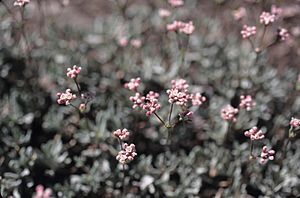Barron's buckwheat facts for kids
Quick facts for kids Barron's buckwheat |
|
|---|---|
 |
|
| Conservation status | |
| Scientific classification | |
| Genus: |
Eriogonum
|
| Species: |
spectabile
|
The Barron's buckwheat (scientific name: Eriogonum spectabile) is a very rare type of wild buckwheat. It is found only in one special place: Plumas County, California. This plant grows in the Lassen National Forest, near a town called Chester.
There are only about 250 of these plants left in the world. This makes it a very important plant to protect!
Contents
What is Barron's Buckwheat?
A Small, Unique Shrub
Barron's buckwheat is a small, bushy plant. It grows low to the ground, like a mat. It can spread out up to 25 centimeters (about 10 inches) wide. It usually stands about 15 centimeters (about 6 inches) tall.
Its stems spread out and have fuzzy leaves. Each leaf is shaped like an oval. They are about 2 centimeters long and 1 centimeter wide.
Its Flowers
When the plant blooms, it sends up thin, straight stems. These stems hold clusters of small flowers. The flowers are white at first. As they get older, they turn pink. They are also a bit fuzzy and sticky. Each flower is only about half a centimeter long.
Where Does It Live?
A Special Mountain Home
This rare plant lives in mountain areas. It prefers places with scattered trees and shrubs. It grows only on certain types of rocky ground. This ground was shaped by ancient glaciers.
How Was It Discovered?
A Recent Find
Scientists found this rare plant quite recently. It was first discovered in 1997. Then, in 2001, scientists officially named it a new species.
Why Is It in Danger?
Threats to Its Survival
The Barron's buckwheat faces several challenges. These challenges make it hard for the plant to survive.
- Logging: One of the biggest dangers is logging. This is when trees are cut down in its forest home.
- Animals Eating Plants: Animals that eat plants can also be a problem. They might eat too much of the buckwheat.
- Other Plants: Sometimes, other plants grow too close. They can take away the water and sunlight the buckwheat needs.
- Climate Change: Changes in the Earth's weather patterns can also affect the plant.
- Forest Fires: The way forest fires happen has changed. This can also harm the plant's natural home.


